How To Make A Great “Neighborway” in Wilmington
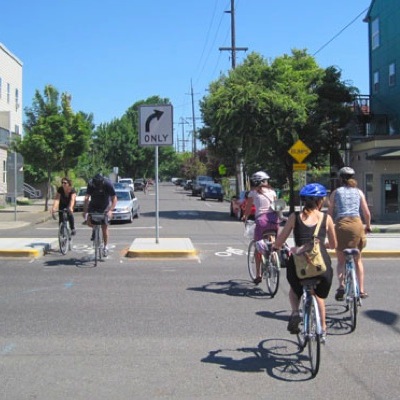
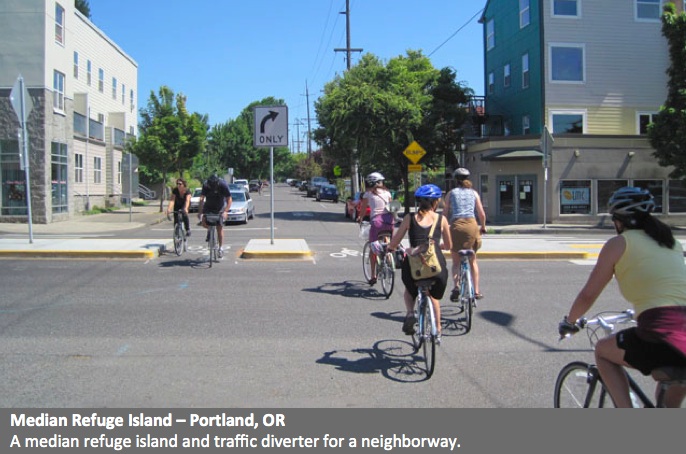
Photo credit: NACTO
TO: Director of Transportation, City of Wilmington Department of Public Works
FROM: James Wilson, Executive Director, Bike Delaware
We are excited about the opportunity presented to Wilmington by a federal Transportation Alternatives program grant and by the idea of using this grant to create a neighborway in the city.
The City of Portland has had as much experience with creating successful neighborways as any city in the country. Their system of neighborways (which they call “neighborhood greenways”) is a central part of their success at making cycling a mainstream and family-friendly transportation option in Portland. Twenty years ago, Portland’s bicycle “mode share” was less than 1%. Today it is more than 6%.
In our conversations with the Portland Department of Transportation, we learned that there are a few simple requirements for successful neighborways:
(1) “neighborway” streets must have a motor vehicle 85th percentile operating speed of no more than 20 mph; and
(2) “neighborway” streets should ideally have a motor vehicle ADT of 500 or less (an ADT of 500 to 1,000 is less preferable but can be accepted); and
(3) intersections, especially with wider, busier roads, must be carefully designed where the neighborway crosses; if cyclists cannot cross busy intersections safely, or perceive that they cannot, they will not use the route.
It is critically important to realize that these three requirements are inter-related. In particular, the street operating speed and volume requirements can often be achieved by appropriate intersection design that prioritizes bicycle through traffic over motor vehicle through traffic on the neighborway by, for example, the use of median refuge islands and traffic diverters:
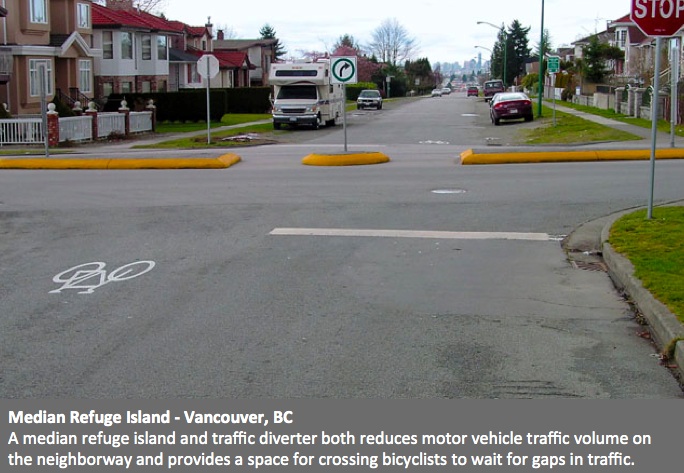
Photo credit: NACTO
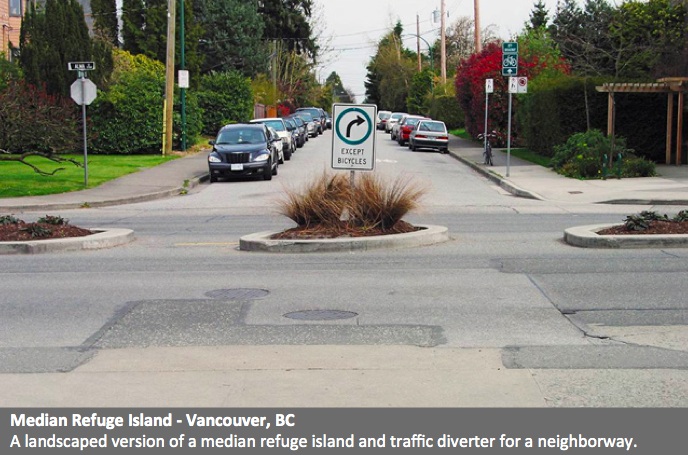
Photo credit: NACTO
Another factor that we would urge you to consider is the lack of any examples (that we were able to find) of one-way neighborways. In every single example we were able to find, successful neighborways are two-way. They are either two-way on two-way streets or they are two-way on one-way streets (with explicit accommodation for contraflow cycling):
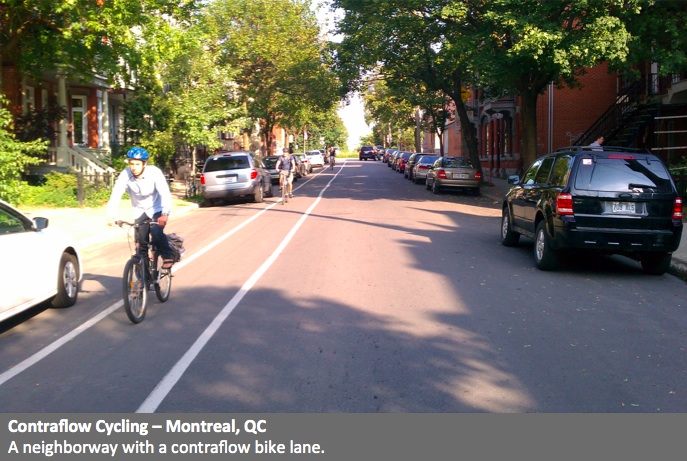
With Wilmington’s large inventory of one-way streets, a clever (and essentially zero cost) alternative to traffic diverters is to simply alternate the permitted direction of motor vehicle traffic every few blocks.
As you develop your design for a neighborway, we ask that you make intersection design the driver of your overall design. We ask that you make certain that motor vehicle operating speed is less than 20 mph and motor vehicle ADT is less than 1,000 on the neighborway. We also urge you to consider that the lack of any successful examples of one-way neighborways (apparently anywhere in the world) strongly indicates that any neighborway for Wilmington must be two-way. (If the street is one-way for motor vehicle traffic that means you must accommodate contraflow cycling.) Finally, and most importantly, if immediately available funding is too tight to create a neighborway with the characteristics required for its success, we strongly advise that you use what funding is available on just one component of a successful neighborway (e.g. a single re-designed intersection with a major road) rather than (for example) spending it all on signage. Signage, while important, is much less important than operating speed, ADT and proper intersection design. An incomplete neighborway with a clear path forward for its completion will only require additional funding. We can make that funding happen. But an ersatz “neighborway” that is just a bunch of signs will be a dead-end that may simply bring the entire concept into disrepute. And, once that happens, who knows when we will ever have another chance in Wilmington?
RELATED:
• Gearing up for new ‘Bicycle Boulevard’ (News Journal)
• Neighborway (Wikipedia)
• Neighborhood Greenways (City of Portland)
• Neighborhood Greenways (PowerPoint presentation from Portland Department of Transportation)


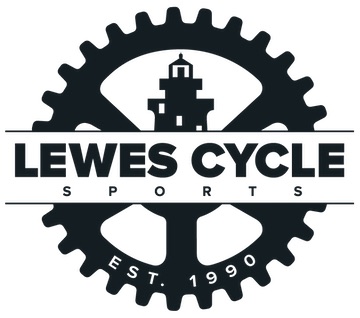
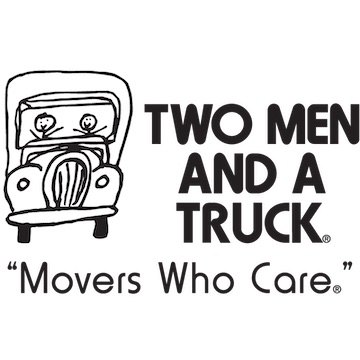
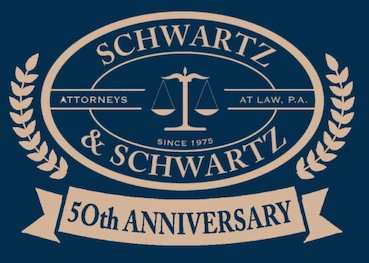
5 Responses
Who is suggesting spending all the money on a “bunch of signs”? Are you referring to the current plans for cross city routes? Sharrows and wayfinding signs don’t fit the description: “a bunch of signs”, and are used successfully in a number of cities and towns. Wilmington has a long ways to go and should be working on intersections and additional routes, but for those of us who regularly bike in the city, the sharrows will be very welcome. At the very least, we can point to the sharrows when motorists question our right to use a road. IMO, Wilmington should also certainly consider tweaking the one way street design, and by doing this and using paint to accommodate contraflow cycling, allow cyclists to have contiguous routes.
I’ve gotta say this. Remember when the Delaware Bicycle Council pursued the re-establishment of “funding pools” during the winter of 2012? Funding pools that in the past brought us projects like the bike lanes on Papermill Road? Well, what you are talking about above are exactly the type of projects that the “pools” would address. Re-establishment of these pools received official approval, although the funding never materialized. Bike DE was one of only two organizations that decided not to support re-establishment of the funding pools. Bike DE, in fact, opposed them. I hope that the above article indicates that you folks have changed your minds and are now behind this idea.
I think you folks raise a few important issues here, especially the issues that can arise for cyclists with one way streets. I would be interested to see if it is feasible to make either 8th or 9th a two-way for bikes. I’m fairly certain 9th Street between Tatnall and Orange would be too narrow for a contraflow bike path, but seems like 8th street has potential. I think the article as a whole, however, is not very applicable as far as Wilmington’s plans for the TA grant. Essentially, this money will help cyclists identify a viable route that already exists, and communicate to both cyclists and motorists that cyclists are a priority on these roads. I agree that it is better to take our time with quality infrastructure and build one piece at a time when necessary rather than create a half-baked route that is ultimately unusable. That is not the case with this route, however, as it is already quite usable. As someone who commutes to Wilmington (I live in Newark) and around Wilmington (I work three different jobs throughout the city) nearly every day, I use the 9th Street and 8th Street routes regularly. The traffic speed is already low – I almost always maintain pace with the cars except on the uphill from the I-95 overpass to the park in the Cool Springs neighborhood. None of the intersections seem like an appropriate place for a median refuge island, though I like the idea in other contexts. All of the photos posted above involved intersections with multi-lane roads that are controlled only by a stop sign. Along the proposed route in Wilmington, nearly all of the intersections are with small, low-volume residential streets. The few exceptions are controlled by traffic lights, providing cyclists with a perfectly safe crossing (Union Street and the I-95 overpass come to mind as comfortably controlled intersections, especially with the addition of road paint to help cyclists position themselves at the lights). A median refuge island can only be applied where there is room for a median, and where there is two-way traffic at the cross street for that matter. Most cross streets don’t even have two-way traffic along this route, so how and why would there be a median refuge? Honestly, sinking all of the money into “infrastructure improvements” at one or two isolated intersections that don’t really need improving, when you could spend the money on a comprehensive and usable route, strikes me as a waste of finite resources. In this case, I’m all about the road paint and the signage.
I agree. It also occurred to me that the TA grant is based on an application that requested money based upon specific plans to develop these cross city routes via sharrows and signage. It’s not feasible to simply take the grant money and use it for something else, to change plans at will.
I agree with the Wilburns… funds better spent using paint. Fortunately, Wilmington has many low volume, neighborhood streets which are great for bicycles… a vast grid network. I would like to see the paired 8th Street and 9th Street bicycle routes established from Union Street to Walnut Street – using paint to incorporate a combined bicycle path and bus stop bulb out (initially a painted bulb-out). Formally marking space for cyclists while also giving a bus stop that does not take away as much residential on-street parking (the current design for a formal “Bus Zone” takes away 3 parking spaces and puts transit in conflict with the residents who potentially ride the bus), should help with providing a boost to alternative modes of transportation. Another benefit hopefully, with a Bus Sided bulb-out, improving the safety for pedestrians crossings? Well, something to consider… paint is cheap and effective. Thanks. David.